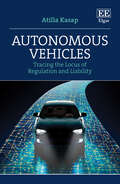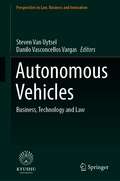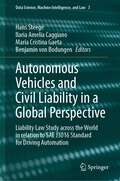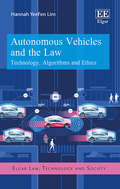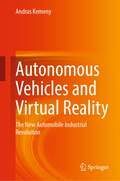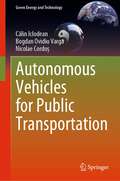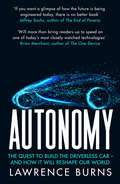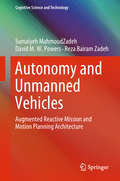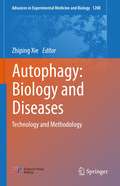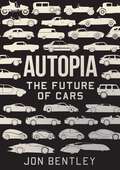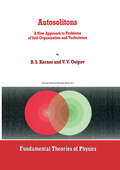- Table View
- List View
Autonomous Vehicles: Tracing the Locus of Regulation and Liability
by Atilla KasapDelving deep into the emerging international and federal statutory and legislative developments surrounding Autonomous Vehicle (AV) technologies, Atilla Kasap assesses whether current motor vehicle regulations, liability law and the liability insurance system are fit for purpose today and in the future.Making a significant and novel contribution to the field, this cutting-edge book comprehensively surveys the promises offered by AVs, including radically reduced road incidents, and economic, environmental and societal benefits, alongside the significant regulatory and liability problems the technology faces. Kasap finds that, as AVs are one of the most significant and profound technological advances of the 21st century, relying on machine learning and pattern recognition systems to function, the current liability regime surrounding them requires a rethinking. Critically analysing the tort liability of AVs, chapters deconstruct and reconstruct a tort law regime for AVs, ultimately solving how policymakers should approach the challenges faced in regulating and enacting AV legislation.Interdisciplinary in approach, it will prove invaluable to students and scholars of computer science and law, particularly those studying AI and robotics law, and those interested in the regulation and governance of AV technology. It also offers vital tools for policymakers seeking concrete principles on which to define potential laws and regulations for AV technology.
Autonomous Vehicles: Business, Technology and Law (Perspectives in Law, Business and Innovation)
by Steven Van Uytsel Danilo Vasconcellos VargasThis edited book aims to address challenges facing the deployment of autonomous vehicles. Autonomous vehicles were predicted to hit the road by 2017. Even though a high degree of automation may have been achieved, vehicles that can drive autonomously under all circumstances are not yet commercially available, and the predictions have been adjusted. Now, experts even say that we are still decades away from fully autonomous vehicles. In this volume, the authors form a multidisciplinary team of experts to discuss some of the reasons behind this delay. The focus is on three areas: business, technology, and law. The authors discuss how the traditional car manufacturers have to devote numerous resources to the development of a new business model, in which the sole manufacturing of vehicles may no longer be sufficient. In addition, the book seeks to introduce how technological challenges are creating a shift toward connected autonomous vehicles. Further, it provides insight into how regulators are responding to the insufficiently tested technology and how lawyers try to answer the liability question for accidents with these autonomous vehicles.
Autonomous Vehicles and Civil Liability in a Global Perspective: Liability Law Study across the World in relation to SAE J3016 Standard for Driving Automation (Data Science, Machine Intelligence, and Law #3)
by Hans Steege Ilaria Amelia Caggiano Maria Cristina Gaeta Benjamin Von BodungenIn the automotive sector, digitalisation, connectivity and automation are rapidly expanding. In tomorrow’s vehicles, human beings will merely be passengers – which raises a host of complex legal issues regarding accidents involving self-driving vehicles. This book is the first to offer a comprehensive, global overview of civil liability regimes for all levels of vehicle automation in jurisdictions that represent some of the most important markets for the automotive industry. After a technical introduction to how self-driving cars work, the individual chapters analyse the liability for driving automation at SAE J3016 levels 0 through 5 from a country-specific perspective. All chapters were written by experts in the field and follow a uniform legal structure. Hence, the book offers an essential comparative analysis of similarities and differences in the jurisdictions examined, while also providing suggestions for future legislative changes at the national and international level. The book is not only relevant for legal scholars and practitioners but will also be of particular interest to anyone involved in the design, manufacture, distribution and operation of self-driving vehicles.
Autonomous Vehicles and Systems: A Technological and Societal Perspective (River Publishers Series in Automation, Control and Robotics)
by Ishwar K. SethiThis book captures multidisciplinary research encompassing various facets of autonomous vehicle systems (AVS) research and developments. The AVS field is rapidly moving towards realization with numerous advances continually reported. The contributions to this field come from widely varying branches of knowledge, making it a truly multidisciplinary area of research and development. The topics covered in the book include: AI and deep learning for AVS Autonomous steering through deep neural networks Adversarial attacks and defenses on autonomous vehicles Gesture recognition for vehicle control Multi-sensor fusion in autonomous vehicles Teleoperation technologies for AVS Simulation and game theoretic decision making for AVS Path following control system design for AVS Hybrid cloud and edge solutions for AVS Ethics of AVS
Autonomous Vehicles and Systems: A Technological and Societal Perspective (River Publishers Series in Automation, Control and Robotics)
by Ishwar K. SethiThis book captures multidisciplinary research encompassing various facets of autonomous vehicle systems (AVS) research and developments. The AVS field is rapidly moving towards realization with numerous advances continually reported. The contributions to this field come from widely varying branches of knowledge, making it a truly multidisciplinary area of research and development. The topics covered in the book include: AI and deep learning for AVS Autonomous steering through deep neural networks Adversarial attacks and defenses on autonomous vehicles Gesture recognition for vehicle control Multi-sensor fusion in autonomous vehicles Teleoperation technologies for AVS Simulation and game theoretic decision making for AVS Path following control system design for AVS Hybrid cloud and edge solutions for AVS Ethics of AVS
Autonomous Vehicles and the Law: How Each Field is Shaping the Other (Synthesis Lectures on Advances in Automotive Technology)
by Ayse Buke HizirogluDisciplines can no longer be isolated. Technology has rapidly evolved to the point that driverless vehicles have truly become a reality and are not something out of a futuristic exhibition from the 1950s. However, engineers and researchers working on the development of autonomous vehicles cannot ignore the policy implications and policymakers as well as attorneys cannot ignore the technology. We are at a point where cross-disciplinary collaboration is vital in order to produce a technology that will immensely benefit society. This is the goal of this book: to educate autonomous vehicle developers on legal theory at the most basic level. Both policymakers and lawyers may also find the book helpful in gaining a basic understanding of the technology the developers are working on.
Autonomous Vehicles and the Law: Technology, Algorithms and Ethics (Elgar Law, Technology and Society series)
by Hannah Y. LimAutonomous vehicles have attracted a great deal of attention in the media, however there are some inconsistencies between the perception of autonomous vehicles’ capabilities and their actual functions. This book provides an accessible explanation of how autonomous vehicles function, including comprehensive explanations of the artificial intelligence (AI) involved, software and hardware, and suggests appropriate regulatory responses to the existing and emerging technology. Hannah YeeFen Lim explores the current capabilities of autonomous vehicles and importantly, highlights their inherent limitations and expounds the machine learning and algorithm pitfalls. Lim provides a concise and easy to follow overview of the technology behind autonomous vehicles which encompasses hardware and software aspects, including machine learning algorithms. Having laid the technical foundation, the following chapters assess the current legal standards in negligence law that are applicable to autonomous vehicles taking into account the current technical limitations of the vehicles. Lim concludes by exploring the ethical issues associated with autonomous vehicles and proposes appropriate regulatory approaches. This book will be of great value to policy makers seeking a deeper understanding of the technology behind autonomous vehicles and the relevant legal landscape in order to inform and guide the development of policies, laws and regulations. Legal practitioners will benefit from the discussion of recent use cases and applicable negligence law. Legal scholars researching artificial intelligence will also find the author’s easy to understand technical explanations and discourse on ethical considerations invaluable.
Autonomous Vehicles and Virtual Reality: The New Automobile Industrial Revolution
by Andras KemenyThis book concisely describes the technologies, human perception, and cognition issues relevant to autonomous vehicles. It also gives an insight in the changes bring about our future everyday lives.Autonomous vehicles are the future of the automobile industry. Automated driving (AD), also called self-driving, raises however several multiple questions, among them those of user safety and acceptation. Comprehensive HMI system design, with windshield display technics, will be necessary to deal with driving task delegations, bringing the use of VR or augmented reality (AR) technologies. In addition, the use of VR for all the vehicle interiors will progressively be proposed for entertainment, online business activities and for modified visual motion perception to alleviate car sickness, a form of motion sickness. Indeed, car sickness is already well known for many passengers, especially when reading or operating smartphones or other display devices. It is called to increase significantly with the introduction of autonomous vehicles where all users will be for long periods in various sitting positions. These two new trends, AD and VR, are already modifying our relationship with the world and the society. All together, they will change our way of life forever. The book will be of interest to professionals in the auto industry, researchers in automotive engineering and computer science and all those interested in the future of transport.
Autonomous Vehicles for Public Transportation (Green Energy and Technology)
by Călin Iclodean Bogdan Ovidiu Varga Nicolae CordoșThis book presents an interdisciplinary approach to autonomous driving technology design and development. It discusses a methodology of simulation that allows specialists to evaluate autonomous vehicle sensors functionality and integration, energy flow, efficiency, range, and service under public transport.The design, calibration, and physical model behind each autonomous vehicle sensor and component is explained. For each specific vehicle, the powertrain is analyzed, and output results are presented through the use of specific automotive industrial software (IPG CarMaker).The book gives the reader a clear perspective of the key factors influencing the global functionality of autonomous shuttle buses with respect to both their inner components the variable exterior factors and an exhaustive legal perspective in relation of their presence on public roads.
The Autonomous Web (Studies in Big Data #101)
by Herwig Unger Mario KubekThis book initiates a transformation of the Web into a self-managing, autonomous information system to challenge today’s all-embracing role of big search engines as centralized information managers. In the last decades, the World Wide Web became the biggest source for all kinds of information needed. After a short review of the state of the art, a Web-based system is presented for the first time, which employs all its instances equally to provide, consume, and process information uniformly and consistently. In order to build such an efficient, decentralized, and fully integrated information space with all its needed functionalities, a set of diverse algorithms is introduced. These novel mechanisms for load balancing, routing, clustering, document classification, but also time-dependent information management pertain to almost all system levels. Finally, three different approaches to decentralized Web search are discussed that represent the backbone of the new autonomous Web.
Autonomy: The Quest To Build The Driverless Car - And How It Will Reshape Our World
by Lawrence Burns’A fascinating hybrid. Part freewheeling history of the rise of the modern autonomous vehicle, part intimate memoir from an insider who was on the front lines for much of that history, Autonomy will more than bring readers up to speed on one of today’s most closely watched technologies’ Brian Merchant, author of The One Device
Autonomy and Artificial Intelligence: A Threat or Savior?
by W. F. Lawless Ranjeev Mittu Donald Sofge Stephen RussellThis book explores how Artificial Intelligence (AI), by leading to an increase in the autonomy of machines and robots, is offering opportunities for an expanded but uncertain impact on society by humans, machines, and robots. To help readers better understand the relationships between AI, autonomy, humans and machines that will help society reduce human errors in the use of advanced technologies (e.g., airplanes, trains, cars), this edited volume presents a wide selection of the underlying theories, computational models, experimental methods, and field applications. While other literature deals with these topics individually, this book unifies the fields of autonomy and AI, framing them in the broader context of effective integration for human-autonomous machine and robotic systems. The contributions, written by world-class researchers and scientists, elaborate on key research topics at the heart of effective human-machine-robot-systems integration. These topics include, for example, computational support for intelligence analyses; the challenge of verifying today’s and future autonomous systems; comparisons between today’s machines and autism; implications of human information interaction on artificial intelligence and errors; systems that reason; the autonomy of machines, robots, buildings; and hybrid teams, where hybrid reflects arbitrary combinations of humans, machines and robots. The contributors span the field of autonomous systems research, ranging from industry and academia to government. Given the broad diversity of the research in this book, the editors strove to thoroughly examine the challenges and trends of systems that implement and exhibit AI; the social implications of present and future systems made autonomous with AI; systems with AI seeking to develop trusted relationships among humans, machines, and robots; and the effective human systems integration that must result for trust in these new systems and their applications to increase and to be sustained.
Autonomy and Independence: Aging in an Era of Technology (Synthesis Lectures on Technology and Health)
by Massimo Poesio Lili Liu Christine DaumThis book looks at how AgeTech can support the autonomy and independence of people as they grow older. The authors challenge readers to reflect on the concepts of autonomy and independence not as absolutes but as experiences situated within older adults’ social connections and environments. Eleven personas of people around the world provide the context for readers to consider the influence of culture and values on how we understand autonomy and independence and the potential role of technology-based supports. The global pandemic provides a backdrop for the unprecedentedly rapid adoption of AgeTech, such as information and communication technologies or mobile applications that benefit older adults. Each persona in the book demonstrates the opportunity for AgeTech to facilitate autonomy and independence in supporting one’s identity, decision making, advance care planning, self care, health management, economic and social participation, enjoyment and self fulfillment and mobility in the community. The book features AgeTech from around the world to provide examples of commercially available products as well as research and development within the field. Despite the promise of AgeTech, the book highlights the “digital divide,” where some older people experience inadequate access to technology due to their geographic location, socio-economic status, and age. This book is accessible and relevant to everyday readers. Older adults will recognize themselves or peers in the personas and may glean insight from the solutions. Care partners and service providers will identify with the challenges of the personas. AgeTech entrepreneurs, especially “seniorpreneurs,” will appreciate that their endeavours represent a growing trend. Researchers will be reminded that the most important research questions are those that will enhance the quality of life of older adults and their sense of autonomy and independence, or relational autonomy and interdependence.
Autonomy and Unmanned Vehicles: Augmented Reactive Mission and Motion Planning Architecture (Cognitive Science and Technology)
by Somaiyeh MahmoudZadeh David M.W. Powers Reza Bairam ZadehThis book addresses higher–lower level decision autonomy for autonomous vehicles, and discusses the addition of a novel architecture to cover both levels. The proposed framework’s performance and stability are subsequently investigated by employing different meta-heuristic algorithms. The performance of the proposed architecture is shown to be largely independent of the algorithms employed; the use of diverse algorithms (subjected to the real-time performance of the algorithm) does not negatively affect the system’s real-time performance. By analyzing the simulation results, the book demonstrates that the proposed model provides perfect mission timing and task management, while also guaranteeing secure deployment. Although mainly intended as a research work, the book’s review chapters and the new approaches developed here are also suitable for use in courses for advanced undergraduate or graduate students.
Autophagy: Technology and Methodology (Advances in Experimental Medicine and Biology #1208)
by Zhiping XieThis book series consists of 3 volumes covering the basic science (Volume 1), clinical science (Volume 2) and the technology and methodology (Volume 3) of autophagy. Volume 3 focuses on the technical aspects of autophagy research. It is comprised of two parts. The first part discusses the basic process of autophagy, including its overall classification and individual stages in the life cycle of autophagosomes. The second part discusses the tools, strategies, and model systems in current autophagy research, including cell and animal models, detection and manipulation methods, as well as screening, genomic, proteomic and bioinformatic approaches. The book is written and edited by a team of active scientists. It is intended as a practical reference resource for interested researchers to get started on autophagy studies.
Autopia: The Future of Cars
by Jon BentleyCars are one of the most significant human creations. They changed our cities. They changed our lives. They changed everything. But in the next thirty years, this technology will itself change enormously. If Google get their way, are we all going to be ferried around in tiny electric bubble-cars? Or will we watch robots race a bionic Lewis Hamilton? And what about the future of classic cars?In Autopia, presenter of The Gadget Show and former executive producer of Top Gear Jon Bentley celebrates motoring's rich heritage and meets the engineers (and coders) who are transforming cars forever. From mobile hotel rooms to electric battery technology; from hydrogen-powered cars to jetpacks, Autopia is the essential guide to the future of our greatest invention. Fully designed with illustrations and photographs, this will be the perfect Christmas gift for car and technology enthusiasts everywhere.
Autoren-Verzeichnis zur Bibliographie der Veröffentlichungen über den Leichtbau und seine Randgebiete im deutschen und ausländischen Schrifttum aus den Jahren 1940 bis 1954 / Author Index to Bibliography of Publications on Light Weight Constructions and Related Fields in German and Foreign Literature from 1940 to 1954: Autoren-Verzeichnis / Authors Index
by Hermann WinterAutos and Progress: The Brazilian Search for Modernity
by Joel WolfeAutos and Progress reinterprets twentieth-century Brazilian history through automobiles, using them as a window for understanding the nation's struggle for modernity in the face of its massive geographical size, weak central government, and dependence on agricultural exports. Among the topics Wolfe touches upon are the first sports cars and elite consumerism; intellectuals' embrace of cars as the key for transformation and unification of Brazil; Henry Ford's building of a company town in the Brazilian jungle; the creation of a transportation infrastructure; democratization and consumer culture; auto workers and their creation of a national political party; and the economic and environmental impact of autos on Brazil. This focus on Brazilians' fascination with automobiles and their reliance on auto production and consumption as keys to their economic and social transformation, explains how Brazil--which enshrined its belief in science and technology in its national slogan of Order and Progress--has differentiated itself from other Latin American nations. Autos and Progress engages key issues in Brazil around the meaning and role of race in society and also addresses several classic debates in Brazilian studies about the nature of Brazil's great size and diversity and how they shaped state-making.
Autos and Progress: The Brazilian Search for Modernity
by Joel WolfeAutos and Progress reinterprets twentieth-century Brazilian history through automobiles, using them as a window for understanding the nation's struggle for modernity in the face of its massive geographical size, weak central government, and dependence on agricultural exports. Among the topics Wolfe touches upon are the first sports cars and elite consumerism; intellectuals' embrace of cars as the key for transformation and unification of Brazil; Henry Ford's building of a company town in the Brazilian jungle; the creation of a transportation infrastructure; democratization and consumer culture; auto workers and their creation of a national political party; and the economic and environmental impact of autos on Brazil. This focus on Brazilians' fascination with automobiles and their reliance on auto production and consumption as keys to their economic and social transformation, explains how Brazil--which enshrined its belief in science and technology in its national slogan of Order and Progress--has differentiated itself from other Latin American nations. Autos and Progress engages key issues in Brazil around the meaning and role of race in society and also addresses several classic debates in Brazilian studies about the nature of Brazil's great size and diversity and how they shaped state-making.
AutoSketch - Zeichenkurs (Viewegs Fachbücher der Technik)
by Hans Georg Harnisch Volker KüchDieses Buch führt in das Arbeiten mit dem Zeichen-Softwarepaket AutoSketch unter PC- und MS-DOS und in dessen Anwendung beim Erstellen technischer Zeichnungen ein. Die Befehle, Funktionen und grundlegenden Vorgehensweisen werden ausführlich behandelt und an praktischen Beispielen veranschaulicht.
Autosolitons: A New Approach to Problems of Self-Organization and Turbulence (Fundamental Theories of Physics #61)
by B.S. Kerner V.V. OsipovThis monograph is devoted to an entirely new branch of nonlinear physics - solitary intrinsic states, or autosolitons, which form in a broad class of physical, chemical and biological dissipative systems. Autosolitons are often observed as highly nonequilibrium regions in slightly nonequilibrium systems, in many ways resembling ball lightning which occurs in the atmosphere. We develop a new approach to problems of self-organization and turbulence, treating these phenomena as a result of spontaneous formation and subsequent evolution of autosolitons. Scenarios of self-organization involve sophisticated interactions between autosolitons, whereas turbulence is regarded as a pattern of autosolitons which appear and disappear at random in different parts of the system. This monograph is the first attempt to provide a comprehensive summary of the theory of autosolitons as developed by the authors over the years of research. The monograph is comprised of three more or less autonomous parts. Part I deals with the physical nature and experimental studies of autosolitons and self organization in various physical systems: semiconductor and gas plasma, heated gas mixture, semiconductor structures, composite superconductors, optical and magnetic media, systems with uniformly generated combustion matter, distributed gas-discharge and electronic systems. We discuss feasibility of autosolitons in the form of highly nonequilibrium regions in slightly nonequilibrium gases and semiconductors, "hot" and "cold" regions in semiconductor and gas plasmas, static, pulsating and traveling combustion fronts.
Autotrophic Nitrogen Removal from Low Concentrated Effluents: Study of System Configurations and Operational Features for Post-treatment of Anaerobic Effluents (IHE Delft PhD Thesis Series)
by Javier Adrián Sánchez GuillénOn a global scale, sewage represents the main point-source of water pollution and is also the predominant source of nitrogen contamination in urban regions. The present research is focused on the study of the main challenges that need to be addressed in order to achieve a successful inorganic nitrogen post-treatment of anaerobic effluents in the mainstream. The post-treatment is based on autotrophic nitrogen removal. The challenges are classified in terms of operational features and system configuration, namely: (i) the short-term effects of organic carbon source, the COD/N ratio and the temperature on the autotrophic nitrogen removal; the results from this study confirms that the Anammox activity is strongly influenced by temperature, in spite of the COD source and COD/N ratios applied. (ii) The long-term performance of the Anammox process under low nitrogen sludge loading rate (NSLR) and moderate to low temperatures; it demonstrates that NSLR affects nitrogen removal efficiency, granular size and biomass concentration of the bioreactor. (iii) The Anammox cultivation in a closed sponge-bed trickling filter (CSTF) and (iv) the autotrophic nitrogen removal over nitrite in a sponge-bed trickling filter (STF). Both types of Anammox sponge-bed trickling filters offer a plane technology with good nitrogen removal efficiency.
Autotrophic Nitrogen Removal from Low Concentrated Effluents: Study of System Configurations and Operational Features for Post-treatment of Anaerobic Effluents (IHE Delft PhD Thesis Series)
by Javier Adrián Sánchez GuillénOn a global scale, sewage represents the main point-source of water pollution and is also the predominant source of nitrogen contamination in urban regions. The present research is focused on the study of the main challenges that need to be addressed in order to achieve a successful inorganic nitrogen post-treatment of anaerobic effluents in the mainstream. The post-treatment is based on autotrophic nitrogen removal. The challenges are classified in terms of operational features and system configuration, namely: (i) the short-term effects of organic carbon source, the COD/N ratio and the temperature on the autotrophic nitrogen removal; the results from this study confirms that the Anammox activity is strongly influenced by temperature, in spite of the COD source and COD/N ratios applied. (ii) The long-term performance of the Anammox process under low nitrogen sludge loading rate (NSLR) and moderate to low temperatures; it demonstrates that NSLR affects nitrogen removal efficiency, granular size and biomass concentration of the bioreactor. (iii) The Anammox cultivation in a closed sponge-bed trickling filter (CSTF) and (iv) the autotrophic nitrogen removal over nitrite in a sponge-bed trickling filter (STF). Both types of Anammox sponge-bed trickling filters offer a plane technology with good nitrogen removal efficiency.
Autotuning of PID Controllers: Relay Feedback Approach (Advances in Industrial Control)
by Cheng-Ching YuRecognising the benefits of improved control, this book aims to provide simple and yet effective methods of improving controller performance. It bridges the gap between the conventional tuning practice and new generations of autotuning methods. Practical issues facing controller tuning are treated, such as measurement noises, process nonlinearity, load disturbances, and multivariable interaction, and tools are also given. Numerous worked examples and case studies are used to illustrate the autotuning procedure, and MATLAB programs to execute autotuning steps are given. This book is intended to be an independent learning tool, and is particularly invaluable to practitioners and scientist, as well as graduate and undergraduate students. The reader will therefore find it useful, particularly as it is applicable to engineering practice
Autotuning of PID Controllers: A Relay Feedback Approach
by Cheng-Ching YuRecognising the benefits of improved control, the second edition of Autotuning of PID Controllers provides simple yet effective methods for improving PID controller performance. The practical issues of controller tuning are examined using numerous worked examples and case studies in association with specially written autotuning MATLAB® programs to bridge the gap between conventional tuning practice and novel autotuning methods. The extensively revised second edition covers: • Derivation of analytical expressions for relay feedback responses. • Shapes of relay responses and improved closed-loop control and performance assessment. • Autotuning for handling process nonlinearity in multiple-model-based cases. • The impact of imperfect actuators on controller performance. This book is more than just a monograph, it is an independent learning tool applicable to the work of academic control engineers and of their counterparts in industry looking for more effective process control and automation.
